 |
| June 22, 2021 | Volume 17 Issue 24 |
Designfax weekly eMagazine
Archives
Partners
Manufacturing Center
Product Spotlight
Modern Applications News
Metalworking Ideas For
Today's Job Shops
Tooling and Production
Strategies for large
metalworking plants
World's most powerful magnet shipped to fusion energy project from U.S.
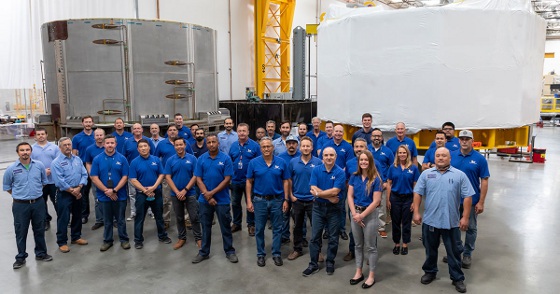
ITER CS Module 1 (shown here at right with the General Atomics fabrication team) is being loaded on a specialized heavy transport vehicle for shipping to Houston, TX, where it will be placed on a ship for transit to France. It will arrive at the ITER site in mid-September. Module 2 (left) will ship later this summer. [Credit: Courtesy General Atomics]
After a decade of design and fabrication, General Atomics of San Diego is ready to ship the first module of the Central Solenoid, the world's most powerful magnet. It will become a central component of ITER (International Thermonuclear Experimental Reactor), a machine that aims to replicate the fusion power of the Sun. ITER is being built in southern France by 35 partner countries.
ITER's mission is to prove energy from hydrogen fusion can be created and controlled on earth. The materials to power society with hydrogen fusion for millions of years are readily abundant. A fusion power plant could use only 5 kg of hydrogen to generate the energy equivalent of 18,750 tons of coal, 56,000 barrels of oil, or 755 acres of solar panels.
To date, ITER is almost 75% built. For the past 15 months, massive first-of-a-kind components have begun to arrive in France from three continents. When assembled, they will make up the ITER Tokamak, a "sun on earth" machine created to demonstrate fusion at industrial scale. The Central Solenoid will play a critical role in ITER's mission to establish fusion energy as a practical, safe, and inexhaustible source of clean, abundant, and carbon-free electricity.
The Central Solenoid, the largest of ITER's magnets, will be made up of six modules. It is one of the largest of the U.S. contributions to ITER. Fully assembled, it will be 18 m (59 ft) tall and 4.25 m (14 ft) wide, and will weigh a thousand tons. It will induce a powerful current in the ITER plasma, helping to shape and control the fusion reaction during long pulses. It is sometimes called the "beating heart" of the ITER machine.
How powerful is the Central Solenoid? Its creators say its magnetic force is strong enough to lift an aircraft carrier 2 m (6 ft) into the air. At its core, it will reach a magnetic field strength of 13 Tesla, about 280,000 times stronger than the Earth's magnetic field. The support structures for the Central Solenoid will have to withstand forces equal to twice the thrust of a space shuttle liftoff.
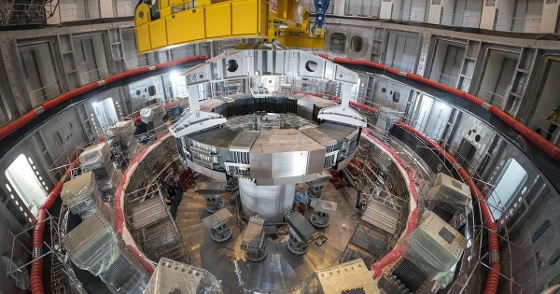
This photo shows the installation of the first superconducting magnet, Poloidal Field Coil #6, in the tokamak pit at the ITER construction site. The Central Solenoid will be mounted in the center after the vacuum vessel has been assembled. [Credit: Courtesy ITER Organization]
Earlier this year, General Atomics completed final testing of the first Central Solenoid module. This week it will be loaded onto a special heavy transport truck for shipment to Houston, where it will be placed on an ocean-going vessel for shipment to southern France.
The Central Solenoid modules are being manufactured at General Atomics's Magnet Technologies Center in Poway, CA, near San Diego, under the direction of the U.S. ITER project, which is managed by Oak Ridge National Laboratory (ORNL). Five additional Central Solenoid modules, plus one spare, are at various stages of fabrication. Module 2 will be shipped in August.
The Magnet Technologies Center at General Atomics was developed specifically for manufacturing the Central Solenoid -- the largest and most powerful pulsed superconducting electromagnet ever constructed -- in partnership with U.S. ITER.
Creating the magnetic fields in a tokamak requires three different arrays of magnets. External coils around the ring of the tokamak produce the toroidal magnetic field, confining the plasma inside the vessel. The poloidal coils, a stacked set of rings that orbit the tokamak parallel to its circumference, control the position and shape of the plasma.
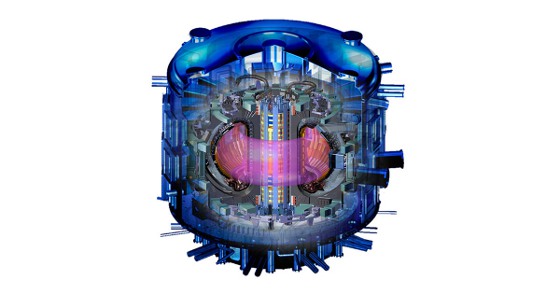
This schematic shows the completed Central Solenoid (blue/yellow column) at the center of the ITER tokamak. The Central Solenoid will drive the plasma current that makes fusion possible. The confined fusion plasma is the pink area inside the tokamak. [Credit: Courtesy U.S. ITER]
In the center of the tokamak, the Central Solenoid uses a pulse of energy to generate a powerful toroidal current in the plasma that flows around the torus. The movement of ions with this current in turn creates a second poloidal magnetic field that improves the confinement of the plasma, as well as generating heat for fusion. At 15 million amperes, ITER's plasma current will be far more powerful than anything possible in current tokamaks.
The superconductor material used in ITER's magnets was produced in nine factories in six countries. The 43 km (26.7 miles) of niobium-tin superconductor for the Central Solenoid was manufactured in Japan. Fabrication of the first module began in 2015.
Together, ITER's magnets create an invisible cage for the plasma that conforms precisely to the metal walls of the tokamak.
ITER aims to be the first fusion device to produce net energy across the plasma, meaning the fusion reaction will generate more thermal energy than the energy required to heat the plasma. ITER will also be the first fusion device to maintain fusion for long periods of time. ITER will generate 500 MW of thermal fusion power, more than 30 times the current record achieved on the JET tokamak in the U.K.
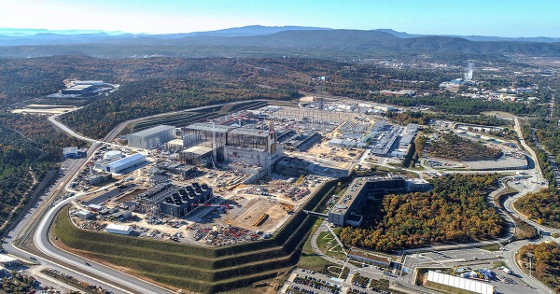
The ITER experiment is under construction at a site in southern France, with first plasma operations scheduled for 2025. The tokamak building is the mirrored structure at center. [Credit: Courtesy ITER Organization/EJF Riche]
ITER will have many capabilities that go well beyond current tokamaks. Though ITER will not generate electricity, it will be a critical testbed for the integrated technologies, materials, and physics regimes necessary for the commercial production of fusion-based electricity. The lessons learned at ITER will be used to design the first generation of commercial fusion power plants.
How the magnets are made
Fabrication consists of 10 custom manufacturing stations for the superconducting magnet that include a 200-ton capacity air-driven transport cart, a 1,200-F two-story convection oven, and a two-story insulating machine to apply 125 miles of fiberglass tape.
Each 4.25-m (14-ft)-diameter, 250,000-lb module requires more than two years of precision fabrication from more than 5 km (3 miles) of steel-jacketed niobium-tin superconducting cable. The cable is precisely wound into flat, layered "pancakes" that must be carefully spliced together.
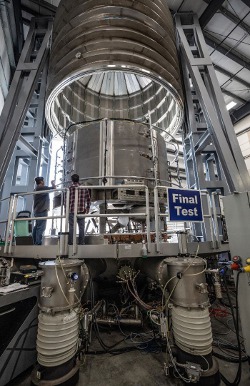
Module 1 of the Central Solenoid in the final stages of testing. [Credit: Courtesy General Atomics]
To create the superconducting material inside the module winding, the module must be carefully heat treated in a large furnace, which functions similarly to that of a convection oven found in many kitchens. The benefit of the convection oven is the ability to shorten the overall process while maintaining uniform "cooking" of the module. Inside the furnace, the module spends approximately 10.5 days at 570 C (1,060 F) and an additional four days at 650 C (1,200 F). The entire process takes about five weeks.
Following heat treatment, the cable is insulated to ensure that electrical shorts do not occur between turns and layers. During turn insulation, the module needs to be un-sprung without overstraining the conductor, which is now strain-sensitive due to heat treatment.
To perform the wrapping, the turns of the module are stretched like a slinky, allowing the taping heads to wrap the fiberglass/Kapton insulation around the conductor. Once the individual turns are wrapped, the external module surfaces are then wrapped with ground insulation. The ground insulation consists of 25 layers of fiberglass and Kapton sheets. The ground insulation must also tightly fit around complex coil features, such as the helium inlets.
After insulation, the module is enclosed in a mold, and 1,000 gallons of epoxy resin are injected under vacuum to saturate the insulation materials and prevent bubbles or voids. When hardened at 127 C (260 F), the epoxy fuses the entire module into a single structural unit.
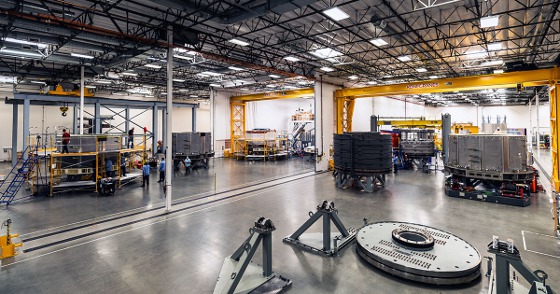
This group photo shows the six Central Solenoid modules in various stages of fabrication at General Atomics' Magnet Technology Center in Poway, CA. Module 1 is visible at far right, while Module 2 is second from left. [Credit: Courtesy General Atomics]
The finished module is subjected to a series of demanding tests, placing it in the extreme conditions it will experience during ITER operation, including near-complete vacuum and cryogenic temperatures required for the magnet to become superconducting (4.5 Kelvin, which equates to about -450 F or -270 C).
Lessons learned on the first Central Solenoid module have been applied to the fabrication of the subsequent six coils.
ITER is a collaboration of 35 partner countries: the European Union (plus the United Kingdom and Switzerland), China, India, Japan, Korea, Russia, and the United States. Most of ITER's funding is in the form of contributed components. This arrangement drives companies like General Atomics to expand their expertise in the futuristic technologies needed for fusion.
SIDEBAR: How does fusion work?
- A small amount of deuterium and tritium (hydrogen) gas is injected into a large, donut-shaped vacuum chamber, called a tokamak.
- The hydrogen is heated until it becomes an ionized plasma, which looks like a cloud.
- Giant superconducting magnets, integrated with the tokamak, confine and shape the ionized plasma, keeping it away from the metal walls.
- When the hydrogen plasma reaches 150 million degrees C -- 10 times hotter than the core of the Sun -- fusion occurs.
- In the fusion reaction, a tiny amount of mass is converted to a huge amount of energy (E=mc2).
- Ultra-high-energy neutrons, produced by fusion, escape the magnetic field and hit the metal tokamak chamber walls, transmitting their energy to the walls as heat.
- Some neutrons react with lithium in the metal walls, creating more tritium fuel for fusion.
- Water circulating in the tokamak walls receives the heat and is converted to steam. In a commercial reactor, this steam will drive turbines to produce electricity.
- Hundreds of tokamaks have been built, but ITER will be the first to achieve a "burning" or largely self-heating plasma.
Source: General Atomics
Published June 2021
Rate this article
View our terms of use and privacy policy
